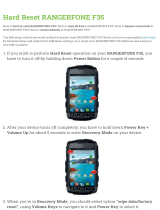
GB 3
PRECAUTIONS AND GENERAL
RECOMMENDATIONS
1.Packaging
• The packaging material is entirely recyclable, and
marked with the recycling symbol . Adhere
to current local regulations when disposing of
packaging material.
2.Disposing of packaging and scrapping
old washing machines
• The washing machine is built from reusable
materials. It must be disposed of in compliance
with current local waste disposal regulations.
• Before scrapping, remove all detergent residues
and cut off the power cable so that the washing
machine is made unusable.
• This appliance is marked according to the
European directive 2002/96/EC on Waste
Electrical and Electronic Equipment (WEEE).
By ensuring this product is disposed of correctly,
you will help prevent potential negative
consequences for the environment and human
health, which could otherwise be caused by
inappropriate waste handling of this product.
The symbol on the product, or on the
documents accompanying the product, indicates
that this appliance may not be treated as
household waste. Instead it shall be handed over
to the applicable collection point for the recycling
of electrical and electronic equipment.
Disposal must be carried out in accordance with
local environmental regulations for waste disposal.
For more detailed information about treatment,
recovery and recycling of this product, please
contact your local city office, your household
waste disposal service or the shop where you
purchased the product.
3.Safety instructions
• The washing machine is appropriate for indoor
use only.
• Do not store flammable fluids near the appliance.
• If you want to place a dryer on top of your
washing machine, first contact our After-Sales
Service or your specialist dealer to verify if this is
possible. Placing a dryer on your washing
machine is only admitted by using an appropriate
stacking kit available through our After-Sales
Service or your specialist dealer.
• Do not leave the appliance plugged in when not
in use.
• Turn off the tap when not in use.
• Before any cleaning and maintenance switch off
the machine or disconnect it from the mains.
• Never open the door forcibly or use it as a step.
• Children must not be allowed to play with the
washing machine or to climb into the drum (see
also the following page chapter “Child Safety”).
• If necessary, the power cable may be replaced
with an identical one obtained from our After-
Sales Service. The power cable must only be
replaced by a qualified technician.
4.Energy saving tips
• Achieve the best use of energy, water, detergent
and time by using the recommended maximum
load size.
• Do not exceed the detergent dosages indicated
in the manufacturer’s instructions.
• The Eco-Ball - a special system in the outlet - will
prevent detergent loss from the drum to avoid
detergent loss into the environment.
• Use “Prewash” for heavily soiled laundry only!
Save detergent, time, water and energy
consumption by not selecting “Prewash” for
slight to normally soiled laundry.
• Pretreat stains with stain remover or soak dried-
in stains in water before washing to reduce the
necessity of a hot wash programme.
• Save energy by using a 60° C instead of a 95° C
wash programme or a 40° C instead of a 60° C
wash programme.
• Save energy and time by selecting a high spin
speed to reduce the water content in laundry
before using a tumble dryer (for machines with
adjustable spin speed).
5.EC Declaration of Conformity
• The appliance conforms to the following
European Standards:
73/23/EEC Low voltage directive
89/336/EEC Electromagnetic Compatibility Directive
93/68/EC CE Marking Directive .
30105900GB.fm Page 3 Tuesday, March 11, 2008 9:44 AM














